Dip into this easy guide to seeing the brightest asteroid, Vesta, and understanding what makes it unique.

Moon image: Gregory H. Rivera; Vesta: NASA / JPL-Caltech / UCAL / MPS / DLR / IDA with additions by the author
A new month is underway, with a bright minor planet strutting its stuff in Leo, the Lion. Grab your binoculars because that's all you'll need to see 4 Vesta, the second largest and brightest main belt asteroid. In early March it's a 6.1-magnitude point of light traveling westward near the 3rd-magnitude star Theta (θ) Leonis, also known as Chertan. Opposition occurs on March 4th, and it's nearest the Earth on the 9th at a distance of 203.6 million km (126.5 million miles).

Piqui Diaz
Even at month's end, Vesta will still be as bright as magnitude 6.5. With the Moon now vacating the evening sky, timing couldn't be better for watching the asteroid's night-to-night perambulations.
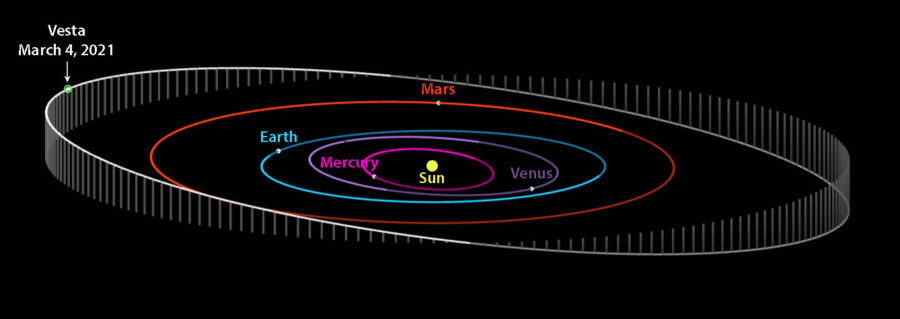
JPL Horizons
Vesta orbits the Sun every 3.6 years with an orbital eccentricity of 0.09, very similar to that of Mars, so its distance and brightness vary significantly from opposition to opposition. This one falls in the middle between close and far with Vesta faintly visible without optical aid from the countryside. Although a fulsome 525 kilometers (326 miles) across, it subtends just 0.5″ this month, appearing completely stellar except in large instruments at high magnification under optimal seeing conditions.
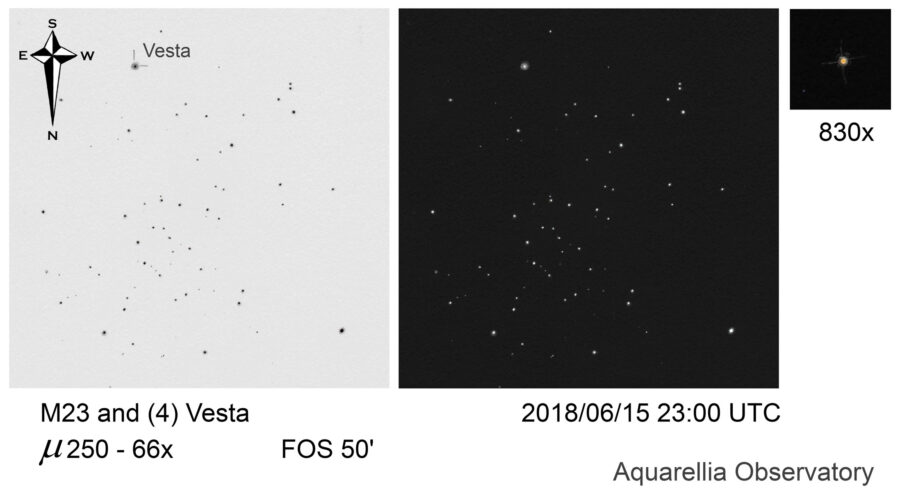
Michel Deconinck
While quite tiny, Vesta's apparent size is nearly nine times larger than that of R Doradus, the star with the largest apparent diameter (0.057″). This makes me wonder whether Vesta might be large enough to mimic a planet and twinkle less than a star of similar magnitude. Has anyone noticed this through the telescope?
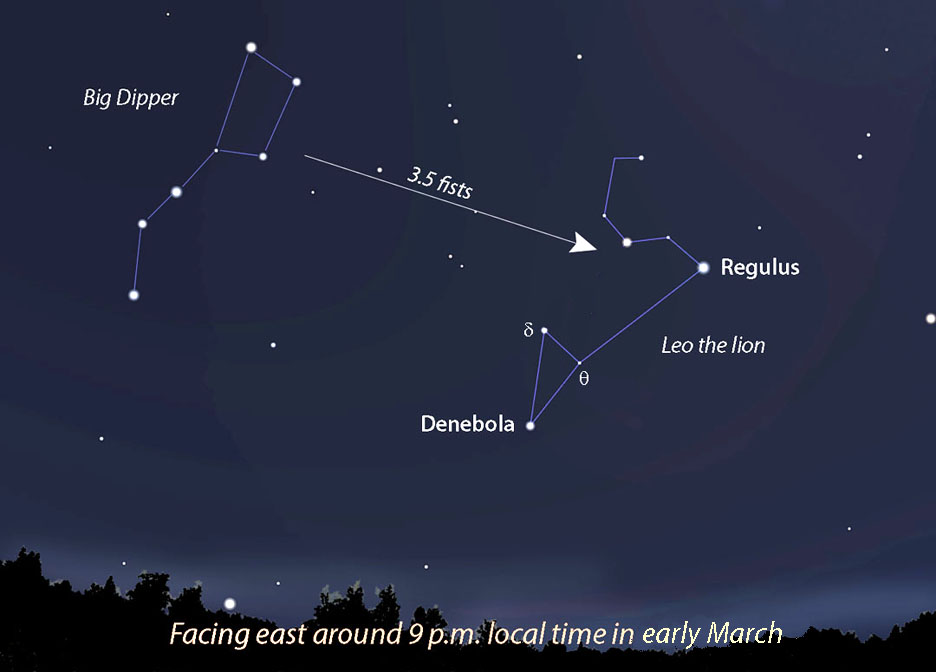
Stellarium with additions by the author
To find Vesta the next clear night, start at Regulus then drop down about 16° to Chertan (θ Leonis), the bottom-right star of the scalene triangle that defines Leo's hindquarters. Vesta remains within 1.5° of the star through March 10th, making it a great place to launch your star-hop. Moving westward in retrograde motion about ¼° a day, a careful observer should be able to easily detect Vesta's night-to-night movement. Many observers, including myself, report that the asteroid appears pale yellow through a telescope.
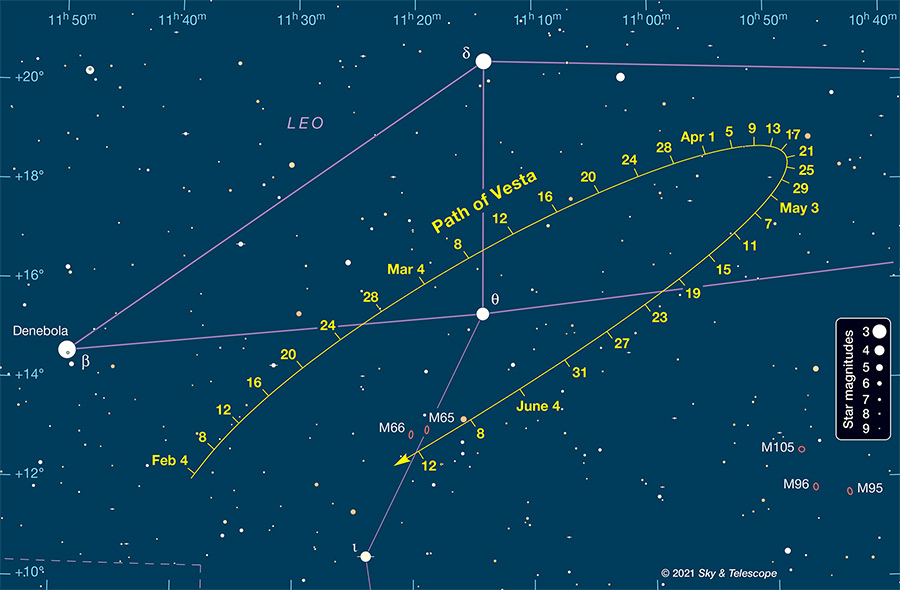
For your best view of the asteroid zoom in with your mind's eye with the help of images returned by NASA's Dawn Mission. Dawn entered orbit around Vesta in 2011 and for 14 months took photos and gathered data on its surface and interior. I encourage you to browse the Photojournal entries for Vesta to prime the imagination before you take that first look in your telescope or binoculars.
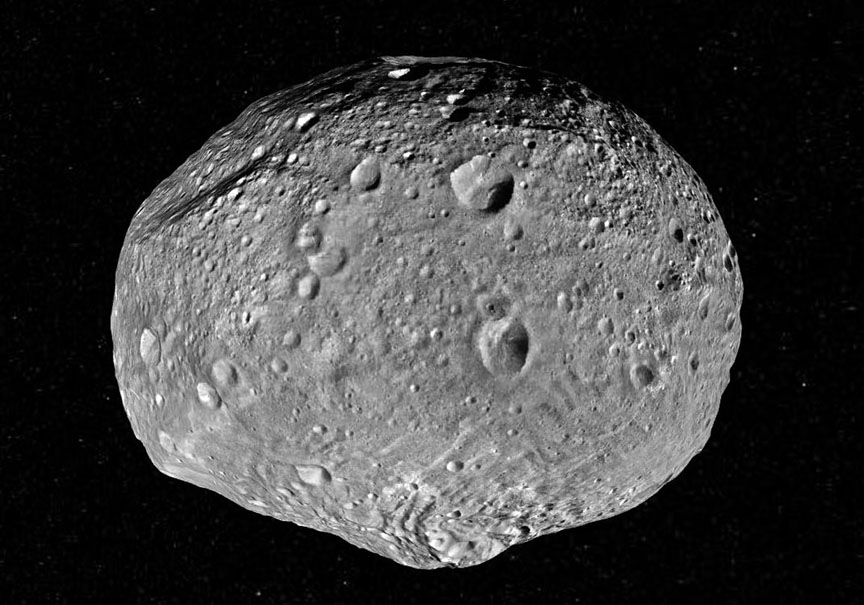
NASA / JPL-Caltech / UCLA / MPS / DLR / IDA
Unlike most asteroids, which are composed of a mishmash of metallic, icy, and rocky materials, Vesta is differentiated or layered, with a metallic core wrapped in a dense, rocky mantle and topped by a crust of cooled lava. Earth has a similar build but grew large enough to achieve planetary status. Vesta got halfway there, stopping at the protoplanet stage.
Early protoplanets like Vesta served as the nuclei of the planets we know today. Astronomers speculate that if it wasn't for the constant agitation of Jupiter's gravity Vesta might have grown into a full-fledged planet itself. Instead, it suffered a case of arrested development and remains the only known embryonic planet to date.
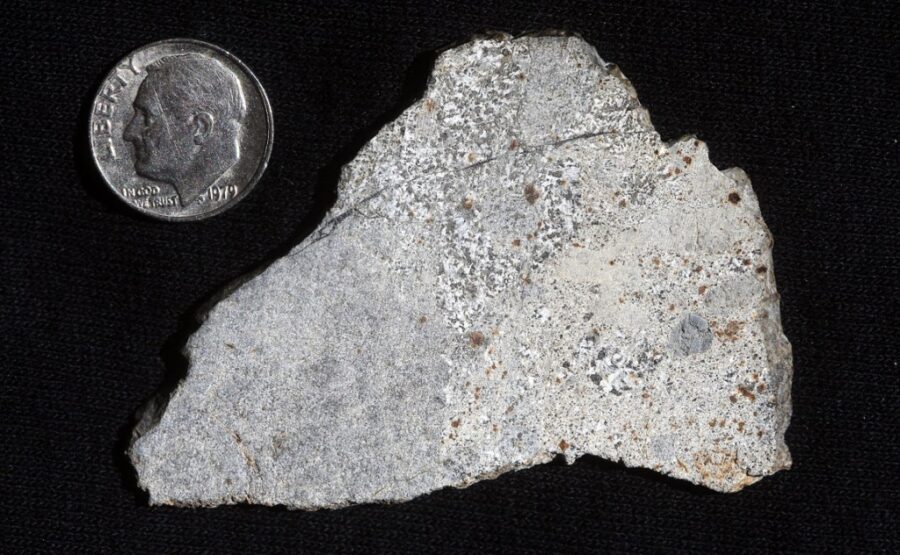
Bob King
Dawn also confirmed that a class of meteorites found on Earth called Howardites, eucrites, and diogenites — together known as the HED clan — derive from the protoplanet. A billion or so years ago another asteroid smashed into Vesta and excavated Rheasilvia Crater, a basin some 500 kilometers (300 miles) across. Nearly 1% of the asteroid was pulverized and blasted into space with enough fragments arriving on Earth over time to account for about 5% of all meteorites known.
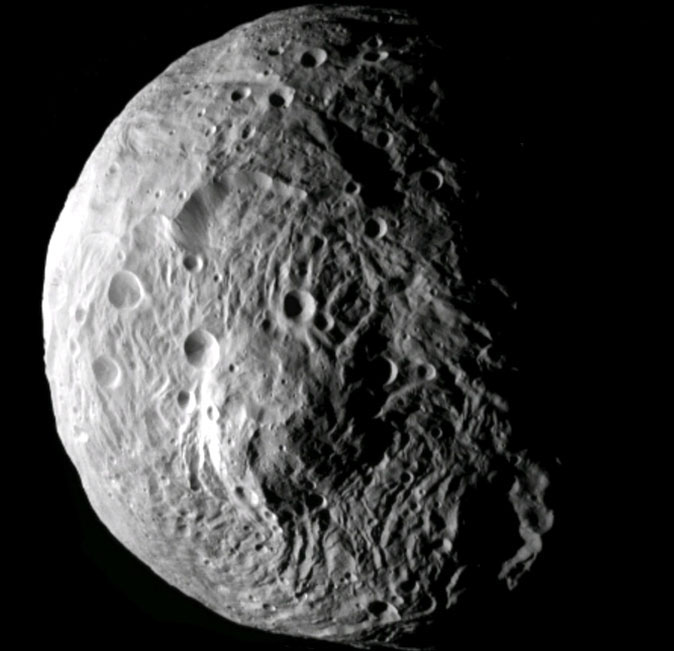
NASA / JPL-Caltech
At the center of Rheasilvia stands a 22-kilometer-tall peak slightly taller than Olympus Mons on Mars. Although not nearly as expansive, this jagged reminder of Vesta's near-catastrophic encounter is the tallest known peak in the solar system.
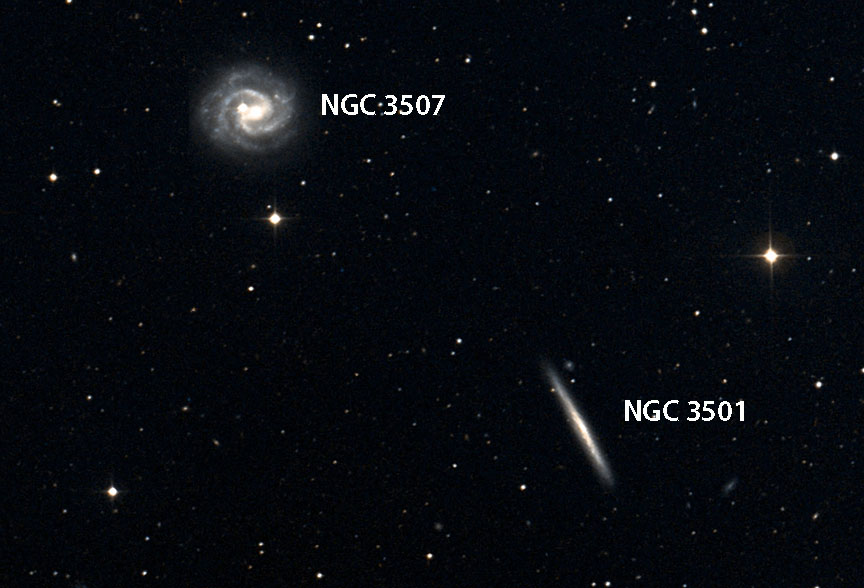
DSS2 / Aladin Sky Atlas
As you accompany Vesta this month, expect to see new sights along the way. On the evening of March 21st, the asteroid passes just 56″ north of the core of the 12.9-magnitude, edge-on spiral NGC 3501 around 10 p.m. EDT. Be sure to look for its neighbor, the face-on, barred spiral NGC 3507 (magnitude 10.9) just 12′ to the northeast at the same time.
Happy hunting!
 14
14
Comments
Anthony Barreiro
March 3, 2021 at 4:39 pm
I don't understand how an asteroid 525 km in diameter can have a 500 km diameter crater.
For the past couple of months I've been enjoying watching Vesta through 10x42 binoculars. Now she's moving noticeably from night to night and getting brighter week by week. Very exciting.
You must be logged in to post a comment.
Michel Deconinck
March 3, 2021 at 7:17 pm
Indeed it comes from a huge impact:
https://en.m.wikipedia.org/wiki/Rheasilvia
You must be logged in to post a comment.
Bob KingPost Author
March 3, 2021 at 11:09 pm
Hi Anthony,
And yet, it happened! If you look at the feature image you can see that the impact at the bottom of Vesta is nearly its diameter.
You must be logged in to post a comment.
jacobus-nl
March 4, 2021 at 5:26 am
I guess the crater is so big that it challenges our intuitive definition of a crater. If an impact almost splits a (minor) planet in half, does that 'leave a crater' or does that 'change the shape of the planet' ?
It seems that whatever we can imagine, it's floating around somewhere in the solar system 🙂
You must be logged in to post a comment.
Anthony Barreiro
March 4, 2021 at 7:15 pm
Jacobus, yes, that's how I'm thinking about it now too. The common-sense definition of a crater is a bowl-shaped depression, a hole in the ground. In order for a crater to be a hole, the object that gets cratered needs to be a lot bigger than the crater. When the crater is almost as big as the object that got cratered, the crater isn't a hole, it's a central peak surrounded by the inferred absence of some of the original spheroid, with a ring of deformation near the object's equator. Not what immediately comes to mind when we think about craters. Rheasilvia is an absurd limiting case of those features which can be classified as craters.
You're right, there's a lot of strange things floating around out there! Keeps the hobby interesting!
You must be logged in to post a comment.
Bob KingPost Author
March 4, 2021 at 7:56 pm
Anthony,
I like your take on this. Maybe we should come up with a new term for such enormous impacts on small bodies. Any suggestions?
You must be logged in to post a comment.
Peter Wilson
March 4, 2021 at 8:20 pm
How about a vestige impact?
You must be logged in to post a comment.
Bob KingPost Author
March 5, 2021 at 10:49 am
Good one, Peter. I think you're heading in the right direction. I was thinking more clunkily as in "sub-catastrophic" impact. Trying to find the right word to describe something at the tipping point of complete destruction while still surviving the blow.
You must be logged in to post a comment.
Rod
March 4, 2021 at 7:05 am
Good report Bob King 🙂 On the evening of 02-March I enjoyed views of 4 Vesta using my 10x50 binoculars in Leo. A note from my log: Observed 1845-1900 EST/2345-0000 UT. 10x50 binocular views of Mars and Pleiades, about 2.5-degrees angular separation. Nice unaided eye view, better in 10x50 binocular view. Mars and a good junk of M45 fit into the same field and Mars a nice bright orange-red. Very lovely sight. These two are separated tonight in their sky position about 2.5-degrees. Someone with a wide field view could get a great picture. Moon rises near 10:06 PM this evening. Tonight waning gibbous, Last Quarter on 06-March. At 1945 EST/0045 UT I viewed 4 Vesta tonight in Leo using 10x50 binoculars. 4 Vesta asteroid near Chertan in Leo, easy 10x50 binocular view tonight. So tonight I viewed Mars, Pleiades cluster and 4 Vesta asteroid in our solar system. Cool stuff 🙂 4 Vesta asteroid mv + 5.82/+5.85 according to Starry Night Pro Plus 8 and Stellarium 0.20.4. March 2021 issue of Sky & Telescope reports 4 Vesta at opposition on 4th of March, 2021.
You must be logged in to post a comment.
Bob KingPost Author
March 4, 2021 at 7:59 pm
Thank you, Rod. And good report yourself! I get the same magnitude on Stellarium, but it differs from several other sources, so I went with JPL Horizons at 6.1. Another source of ephemerides by Meeus gives 6.2.
You must be logged in to post a comment.
Anthony Barreiro
March 4, 2021 at 9:26 pm
Should we call Rheasilvia a whack-a-mole-zilla?
You must be logged in to post a comment.
Bob KingPost Author
March 5, 2021 at 10:50 am
Anthony,
Yes! If only for giggles 🙂
You must be logged in to post a comment.
Mark-Moyer
March 8, 2021 at 8:52 am
I was barely able to see it naked eye. I could hold it in view only for about a second, but I was able to do this several times (maybe due to poor seeing here?). Many thanks for the challenge and the great article (always love a Bob King piece!).
You must be logged in to post a comment.
TomR
March 8, 2021 at 10:21 am
Hi Bob,
thanks for your article!
I’ve tried to estimate the discs of some objects during a perihel-oppsition:
Vesta: Min. distance: 1,3 AU Diameter: 550 km, Disc-Diameter: 0,58“
Ceres: Min. distance: 1,6 AU Diameter: 1000 km, Disc-Diameter: 0,86“
Ganymed: Min. distance: 4 AU Diameter: 5260 km, Disc-Diameter: 1,8“
Neptun: Min. distance: 29 AU Diameter: 49000 km, Disc-Diameter: 2,3“
(Please check it)!
Thomas, Austria
You must be logged in to post a comment.
You must be logged in to post a comment.